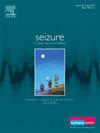可逆性脾损害综合征新生癫痫的预测因素
IF 2.7
3区 医学
Q2 CLINICAL NEUROLOGY
引用次数: 0
摘要
目的可逆性脾损害综合征(RESLES)是东亚一种少见的神经系统疾病,预后良好。在此,我们研究了RESLES患者新发癫痫的预测因素。方法本单中心队列研究在日本仙台医学中心进行,纳入2008年2月至2023年5月期间无癫痫史的RESLES患者,随访至少1个月。结果为RESLES期间或之后的从头癫痫,无其他癫痫病因。比较A组和B组癫痫患者在RESLES入院期间的变量。采用Mann-Whitney U或Fisher精确检验进行统计分析。结果22例患者(男性11/22;50%)符合纳入标准。平均年龄37±20岁,中位随访时间35.9个月(2.4 ~ 199个月)。病因包括感染(10/22,45.5%)、脑血管疾病(3/22,13.6%)和其他(8/22,36.4%)。急性症状包括发热(14/22,63.6%)、精神状态改变(19/22,86.4%)、癫痫发作(8/22,36.4%)和癫痫持续状态(2/22,9.1%)。MRI示脾脏病变(平均垂直长度7.0±1.7 mm,平均水平长度14.2±7.6 mm),胼胝体脾外病变(1/22;4.5%)。9.1%(2/22)发生从头癫痫。癫痫持续状态(2 vs 0;P = 0.001),长水平脾病变(24.7 mm vs 13.2 mm;P = 0.04),使用抗癫痫药物(3 vs 2;结论RESLES急性期癫痫持续状态可预测癫痫的发展。本文章由计算机程序翻译,如有差异,请以英文原文为准。
Predictive factors of de novo epilepsy in reversible splenial lesion syndrome
Purpose
Reversible splenial lesion syndrome (RESLES) is a rare neurological disorder in East Asia with good prognosis. Herein, we investigated the predictive factors for de novo epilepsy in RESLES.
Method
This single-centre cohort study was conducted at Sendai Medical Center in Japan, enrolling patients with RESLES without previous epilepsy treated between February 2008 and May 2023 with follow-up for at least 1 month. The outcome was de novo epilepsy during or after RESLES without other aetiologies of epilepsy. The variables during RESLES admission were compared between patients with (Group A) and without (Group B) de novo epilepsy. Statistical analyses were performed using the Mann–Whitney U or Fisher’s exact tests.
Result
Twenty-two patients (males 11/22; 50 %) met the inclusion criteria. The mean age and median follow-up duration were 37 ± 20 years and 35.9 months (range: 2.4 to 199 months), respectively. The aetiologies included infection (10/22, 45.5 %), cerebrovascular disorders (3/22, 13.6 %), and others (8/22, 36.4 %). Acute symptoms included fever (14/22, 63.6 %), altered mental status (19/22, 86.4 %), seizures (8/22, 36.4 %), and status epilepticus (2/22, 9.1 %). MRI showed splenial lesions (mean vertical length 7.0 ± 1.7 mm and mean horizontal length 14.2 ± 7.6 mm) and extra splenium lesions of corpus callosum (1/22; 4.5 %). 9.1 % (2/22) developed de-novo epilepsy. Status epilepticus (2 vs 0; p = 0.001), long horizontal splenial lesions (24.7 mm vs 13.2 mm; p = 0.04), use of anti-seizure medication (3 vs 2; p = 0.04) were significantly more common in Group A than B.
Conclusion
Status epilepticus during the acute phase of RESLES may predict the development of epilepsy.
求助全文
通过发布文献求助,成功后即可免费获取论文全文。
去求助
来源期刊

Seizure-European Journal of Epilepsy
医学-临床神经学
CiteScore
5.60
自引率
6.70%
发文量
231
审稿时长
34 days
期刊介绍:
Seizure - European Journal of Epilepsy is an international journal owned by Epilepsy Action (the largest member led epilepsy organisation in the UK). It provides a forum for papers on all topics related to epilepsy and seizure disorders.
 求助内容:
求助内容: 应助结果提醒方式:
应助结果提醒方式:


